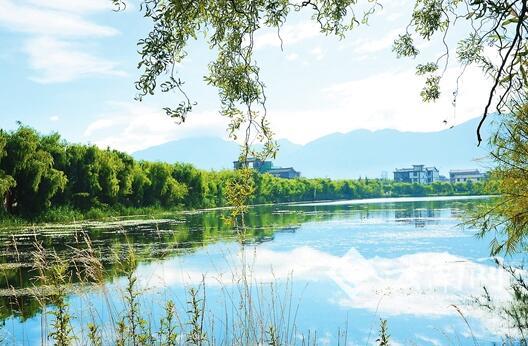Dongcaohai National Wetland Park in Heqing County, Dali
Yunnan Heqing Dongcao Sea National Wetland Park (Yúnnán Hèqìng Dōngcǎohǎi Guójiā Shīdì Gōngyuán, 云南鹤庆东草海国家湿地公园) is located in the northern part of Heqing County (Hèqìng Xiàn, 鹤庆县), Dali Bai Autonomous Prefecture (Dàlǐ Bái Zìzhìzhōu, 大理白族自治州), Yunnan Province (Yúnnán Shěng, 云南省). The park covers a total area of 269.10 hectares, with 210.18 hectares classified as wetland, resulting in a wetland ratio of 78.10%. It was included in the National Forestry and Grassland Administration’s list of “National Wetland Parks Approved in 2020” on December 25, 2020.
Location and Management
- Geographical Location: Heqing County, Dali Bai Autonomous Prefecture, Yunnan Province.
- Area: 269.1 hectares.
- Management Authority: Dongcao Sea Wetland Park Protection Management Bureau (Dōngcǎohǎi Shīdì Gōngyuán Bǎohù Guǎnlǐjú, 东草海湿地公园保护管理局).
- Approval Date: December 25, 2013.
Geographic Environment
Location and Terrain
The park is situated within the ancient Tuntai Wetland area of the Dongcao Sea wetland. It is located in the northern part of Heqing County and is characterized by a flat terrain, with an average elevation of 2,193.8 meters. Heqing County is positioned east of the Yunling Mountain Range (Yúnlǐng Shānmài, 云岭山脉) and serves as a transition area between the northwest mountainous region of Yunnan and the central plateau.
Topography
Heqing County features a complex landscape with varying elevations, including significant mountains such as Ma’er Mountain (Mǎ’ér Shān, 马耳山), Dahei Mountain (Dàhēi Shān, 大黑山), Shibaoshan Mountain (Shíbǎoshān, 石宝山), and Jizu Mountain (Jīzú Shān, 鸡足山). The terrain descends in a staircase-like fashion from the northwest to the southeast, resulting in diverse landforms, including basins and valleys. The highest point is 3,958.4 meters at the summit of Ma’er Mountain, while the lowest is 1,162 meters at the Jinsha River (Jīnshā Jiāng, 金沙江) near Longkai K口 Town.
Hydrology
The eastern part of Dongcao Sea Wetland Park features the Yangong River (Yàngōng Jiāng, 漾弓江), while the northern and western sides have various water bodies, including Dalongtan, Shizhuang Longtan, and Bailongtan, which are crucial for the wetland’s groundwater replenishment. Major rivers within the park include Qingshui River (Qīngshuǐ Hé, 清水河), Wulong River (Wǔlóng Hé, 五龙河), and others, primarily sourcing their water from groundwater and precipitation.
Soil Composition
The soil within the park is lake deposit-based, consisting mainly of clay and silt. Some areas also contain peat clay and coal layers. The soil quality is generally uniform and well-sorted, forming after the draining of lake waters.
Climate Characteristics
The park is characterized by a high-altitude monsoon climate with dry winters and wet summers. It features distinct wet and dry seasons, with an average annual temperature of 13.8°C, annual precipitation of 997.3 mm, and an average sunshine duration of 2,293.6 hours.
Resource Overview
Plant Resources
The park is home to 64 families, 147 genera, and 184 species of vascular plants. Dominant families include Polygonaceae, Compositae, Potamogetonaceae, Cyperaceae, and Gramineae. The plant community reflects a transition from subtropical to tropical species.
Animal Resources
According to the Chinese Animal Geography classification, the Dongcao Sea area belongs to the East Asian–Southwest Region–Himalayan Subregion. The park and surrounding wetlands host 237 species of wildlife across 27 orders and 67 families.
Fish Species
There are 20 fish species recorded in the park, predominantly from the Cyprinidae family. Rare species include the Yunnan Schizothorax (Schizothorax yunnanensis), with common species such as grass carp (Ctenopharyngodon idellus) and common carp (Cyprinus carpio).
Amphibians
The wetlands are home to 10 species of amphibians, primarily frogs.
Reptiles
There are 5 species of reptiles recorded, mainly from the colubrid family.
Bird Species
A total of 192 bird species belong to 16 orders and 46 families, representing 14.67% of the total bird species in China. Notably, the black stork (Ciconia nigra) is a nationally protected species in the park.
Mammals
The park has 10 species of mammals across 4 orders and 6 families, with common species including the field mouse (Microtus fortis) and yellow weasel (M. sibirica).
Development and Construction
The planning and construction period for the wetland park was from 2013 to 2020, divided into three functional areas: ecological conservation area, restoration area, and rational use area.
How to Get There
- By Bus: From Dali City (Dàlǐ Shì, 大理市), take a bus to Heqing County. Local transportation options are available to reach the park.
Travel Tips
- Best Time to Visit: Spring and autumn provide the best weather for exploring the park.
- Photography: Capture the stunning landscapes and wildlife, but be mindful of any restrictions.
- Local Cuisine: Try local Heqing dishes at nearby eateries to enrich your travel experience.
- Respect Nature: Follow park guidelines to preserve the delicate wetland ecosystem.
Dongcao Sea National Wetland Park is not only a vital ecological site but also a haven for biodiversity, making it a must-visit for nature lovers and environmental enthusiasts.

 7 Days GolfingTour
7 Days GolfingTour
 8 Days Group Tour
8 Days Group Tour
 8 Days Yunnan Tour
8 Days Yunnan Tour
 7 Days Shangri La Hiking
7 Days Shangri La Hiking
 11 Days Yunnan Tour
11 Days Yunnan Tour
 6 Days Yuanyang Terraces
6 Days Yuanyang Terraces
 11 Days Yunnan Tour
11 Days Yunnan Tour
 8 Days South Yunnan
8 Days South Yunnan
 7 Days Tea Tour
7 Days Tea Tour
 8 Days Muslim Tour
8 Days Muslim Tour
 12 Days Self-Driving
12 Days Self-Driving
 4 Days Haba Climbing
4 Days Haba Climbing
 Tiger Leaping Gorge
Tiger Leaping Gorge
 Stone Forest
Stone Forest
 Yunnan-Tibet
Yunnan-Tibet
 Hani Rice Terraces
Hani Rice Terraces
 Kunming
Kunming
 Lijiang
Lijiang
 Shangri-la
Shangri-la
 Dali
Dali
 XishuangBanna
XishuangBanna
 Honghe
Honghe
 Kunming
Kunming
 Lijiang
Lijiang
 Shangri-la
Shangri-la
 Yuanyang Rice Terraces
Yuanyang Rice Terraces
 Nujiang
Nujiang
 XishuangBanna
XishuangBanna
 Spring City Golf
Spring City Golf
 Snow Mountain Golf
Snow Mountain Golf
 Stone Mountain Golf
Stone Mountain Golf














